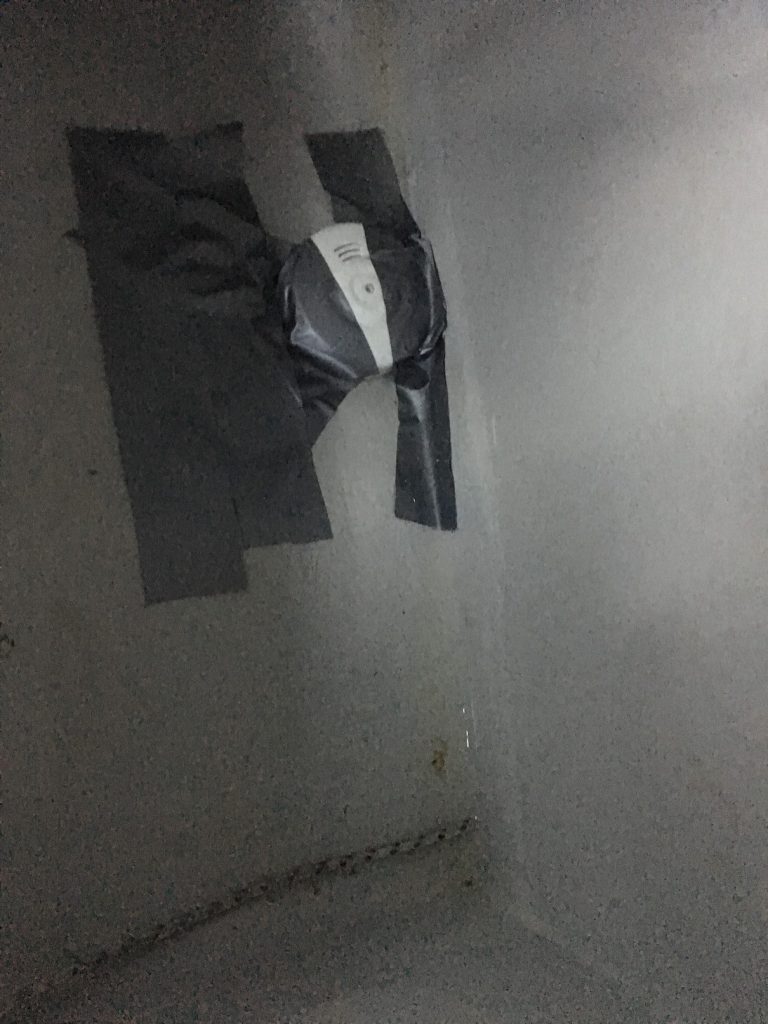In theory one imagines a variety of things that will be of use on a ship. In real life, only time and constant use will tell the strengths and weaknesses of the boat and the equipment. When living on a boat and sailing in various waters it shows very quickly what stands the test and what does not. In the following we discuss several construction characteristics and equipment choices based on our experience during our sabbatical. Maybe this list will serve as an inspiration and assistance for inspiring sailors who are planning a similar adventure.
Our Equipment – What Worked, What Didn’t

The Hull and the Structure

Our boat’s most loved feature can be summed up in one word: deck saloon.
There is hardly anything we enjoyed as much as this perfectly executed concept: unobstructed view on eyelevel whether we anchor, stay in a harbor or are sailing. While other sailors sit downstairs ‘in the basement’ or outside, we are comfortable and cozy with a 360° view. Especially during spring and fall, in rather wet climates (Norway, Scotland and Ireland) as well as throughout longer passages, a deck saloon proved to make life easier: steering the ship from the warm inside is a treat!
Moreover, even during hot climates – Portugal in August – the double glazed windows provided a pleasant temperature. The well thought through, two storey concept with the master cabin beneath the saloon provided us with plenty of space, usually found on a 47-foot yacht. Whenever we had to maneuver into a small harbor spot, we were glad the Amazing Grace was actually a graceful 40-footer. To sum it up: we will probably never go back, deck saloon for life!
Another feature, which made us choose a Sirius Yacht was the twin keel concept. Even though we had never sailed a yacht like that and were aware of the prejudice against its performance sailing close to the wind, we are glad we made that choice, as reality is a lot different: We are able to tack less than 80° and our draught of 1,45 m opens up a whole new world of harbors, bays and anchor areas for us. However, it is most exciting to sail into a bay during the flood and then –slowly but steady- run dry. During stormy nights we only have to spend one bumpy hour free swinging before resting on our two ‘legs’ again.
The only disadvantage: if you run aground, heeling is of no use. If freeing oneself with the motor does not help, the only option is to wait for the flood. To put it in a nutshell: when sailing in tidal areas, a twin keel is the best option. However, it is an unnecessary feature should one only sail in areas with a minimal tide, like the Mediterranean.
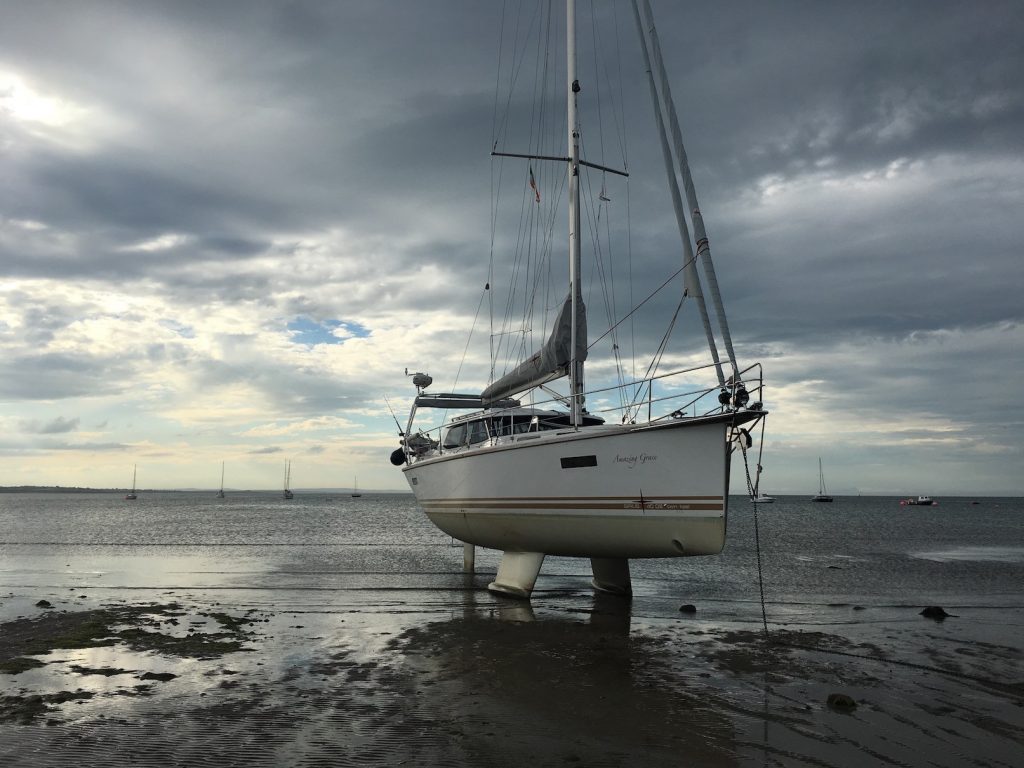
Rigging and Sails
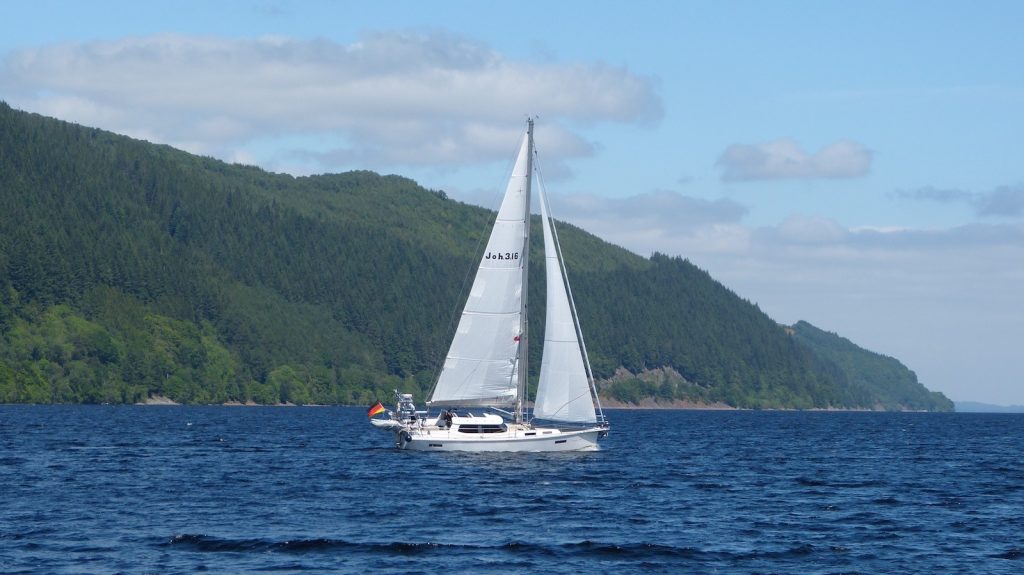
Our main sail is fully battened and has three reefs. The two head sails contain one 135 percent roller furling genoa and one self-tacking jib without backstays. This is our permanent sail configuration and the cause for a great sailing performance – who wants to be outraced?
During low winds between 50° and 150°, we use a rolldrifter, which is attached with a wheel at the bowsprit. When running before the wind we sail goose wings.
We pole out the genoa and fix the main sail. Most of the times, we fully set the head sails without reefs for maximum sailing performance. When sailing close to the wind, we reef the main sail once or twice while keeping the genoa unreefed. Then we switch to the jib and unreef the main sail.
This set up of sails has proven to be very variable, while still being easy to handle as well as being high in performance. Most of the time, we were faster and closer to the wind as other yachts of comparable size, while travelling was still comfortable.
The self-tacking jib fully convinced us on Loch Ness, which helped us conquer the famous Loch with 24 tacks. Reefing the main is easy, it only needs a little tuck on one rope in the cockpit. In a worst-case scenario the main comes down in one second – an important safety feature! We did not miss the in-mast furling main sail of our previous yacht. Three reefs was all we needed for every wind we encountered. Also, we never used our storm sail. For the future, especially for longer trips with rear winds, we are thinking about a sail which is very easy to handle and can be set at nights with a very small crew.
Navigation and Communication
We decided against a windvane steering system and put our trust completely in ‘Rayma’, our electrical autopilot. She steered us at least 80 % of the time and was reliable during almost all wind and wave conditions. She only needed a little help for sudden changes of course, until she had adjusted to the new circumstances. Even for longer crossings, our battery block of 525 Ah was sufficient enough for using the autopilot. When the sun is out it even gets new juice! In the future we will continue to stay clear of the redundancy of a windvane steering system and will trust our ‘Rayma’. Also it saves a ton of space on the rear for our dinghy and the fold-out swimming platform. However, next time, we will pack some spare parts for the autopilot – you never know!

Regarding communication: we did without Navtex, but took the satellite phone ‘Iridium Extreme’ with us, for which we installed an external antenna on our gear carrier. This was for us the most flexible solution as we were able to receive gribfiles everywhere and load them onto our laptop. Also we were always able to call harbors or sea rescue services as well as be available for our children on long legs away from shore. Aside from that, we only had UKW on board, which was sufficient enough. Almost every marina has Wifi nowadays, although it often was too bad to upload our blogposts. Without our own cellphone hotspot and a very cheap phone contract which applied to all of the EU, there would have been no blog. We will consider a Wifi amplifier for the future.
Interior design
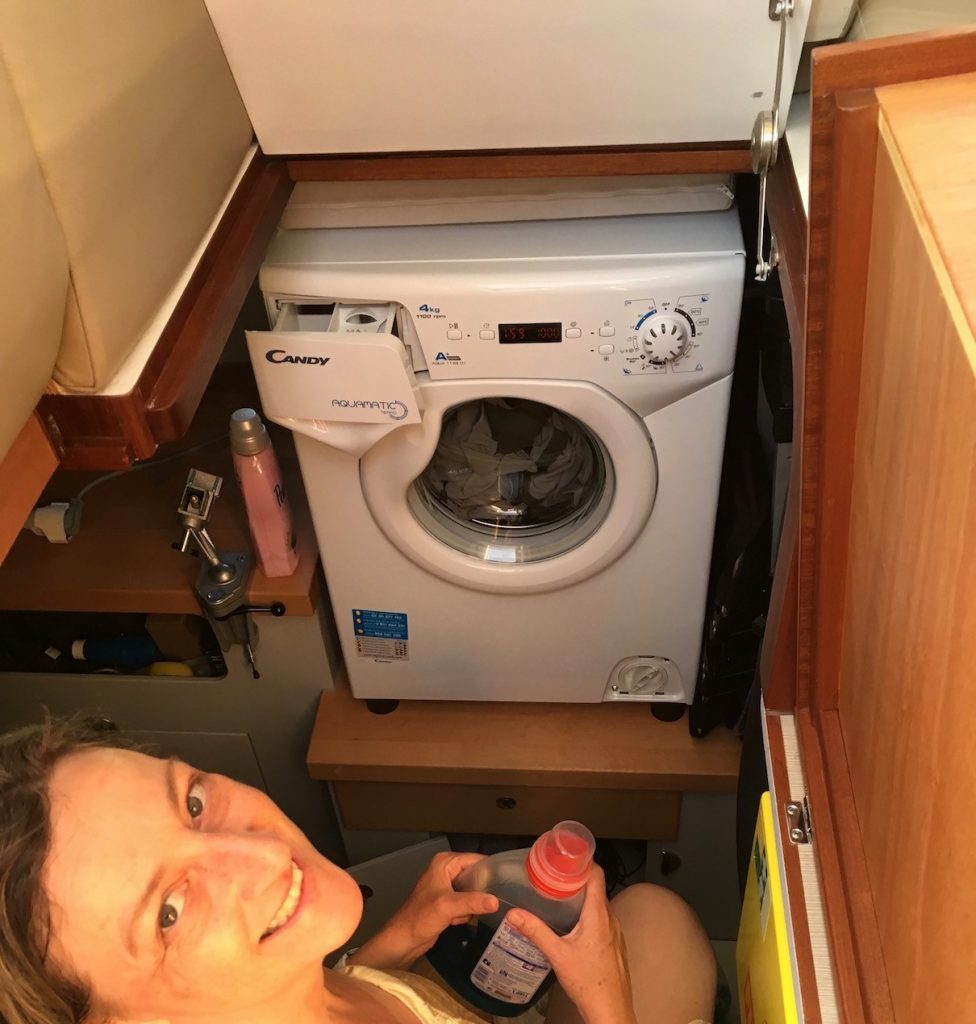
It is pure luxury for some, but when you live on a boat for quite some time during mostly ghastly weather, a washing machine has its perks! One time, in Denmark, we witnessed two worked up husbands almost get rough over the question, whose wife was next in line for washing their clothes. Problems, we no longer have! In the south, where all one wears and washes is a bikini, it might seem ridiculous, but having to hurl heavy winter clothes through the rain to the next washing machine is no fun! It also has a fun ‘ahh’ and ‘ohhh’ effect, when we fold down the seat and unveil not only a mini-workshop, but also a washing machine. No one expects one on a 40-foot yacht. The well thought-through concept of our deck saloon yacht makes it possible.
The amidships berth underneath the saloon is our favorite one. It not only has a big bed surface but also three very big windows with a fantastic view onto bays or sunsets. It is also the most calm place on the boat, where one is able to sleep even during longer crossings which had stern and hull shaking.

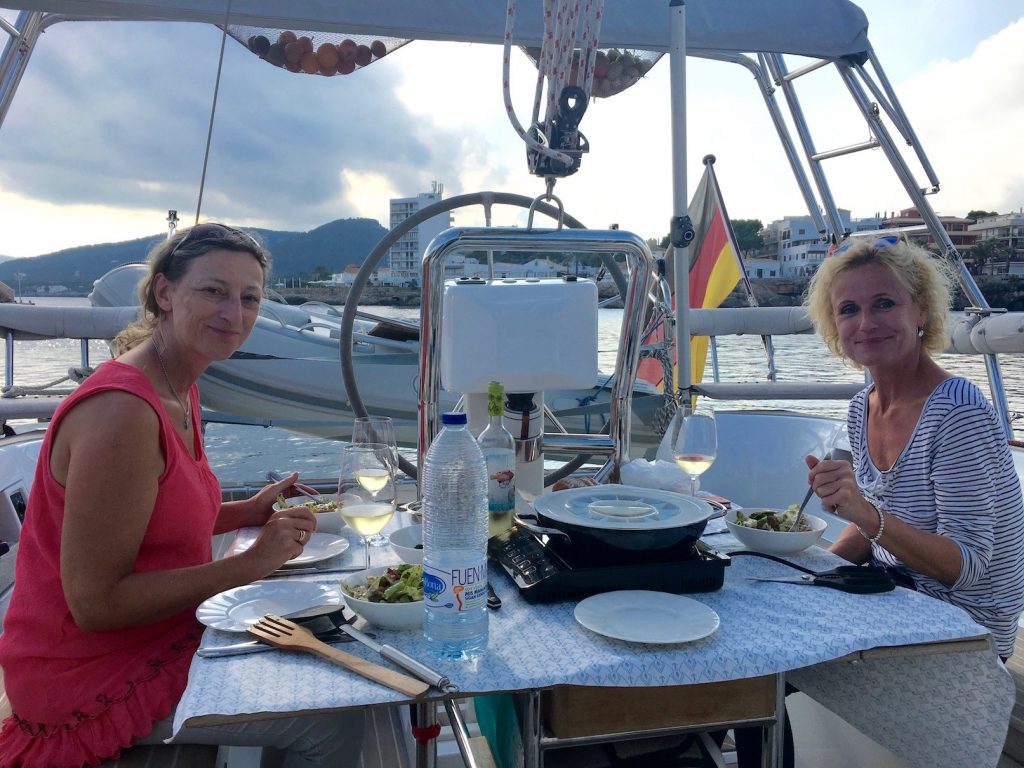
Cooking: For us, the best solution is a two-flame gas stove, as it is always in balance – contrary to many three-flame stoves. In seven months we only used up three camping gas cylinders, which one can buy everywhere. We managed to save the gas because we also took one induction hob with us, which was always in use, when we had a shore power connection. Sometimes we even used it on the go with the help of our inverter. Cooking on an induction hob is much faster than cooking with gas, even with only one hob. The hob fits perfectly onto the stove and can also be used outside, in the cockpit where we connect it to an outlet in one of the storage boxes. Smelly or messy foods are cooked outside, which keeps the kitchen clean and adds the vibe of an outdoor live-cooking event.
Fittings
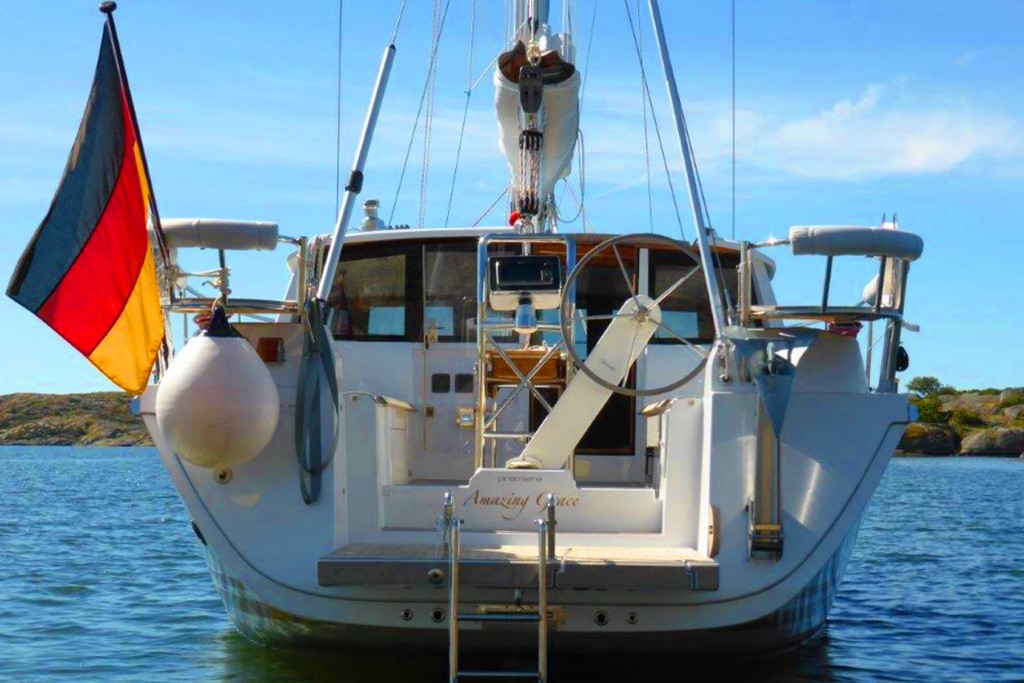
Steering: The Amazing Grace is equipped with a one-wheel steering, which can be switched from left to right with a foot pedal. This feature proved very helpful as it provides a perfect view for every course – as if we had two helmstands. However, with only one steering wheel, the benches in the cockpit are as long as the ones found on a 50 foot yacht. This makes stargazing at night comfortable for everyone – even tall Germans!
This steering method is a big plus and certainly much more comfortable than the double helm solution of our old yacht.
Anchor: No marina is as beautiful as natural anchorages are. We love throwing our anchor and enjoying the peace and quiet. This is why the right anchor equipment was key to us. Our main anchor, the 25 kg Rocna, has proven reliable and secure in all tidal areas as well as all anchorage grounds. 100 m Duplex stainless steel chain, electropolished, 1.4462 bzw. AISI 318LN CROMOX, gave us also in warm waters additional safety. The anchor always held, after we thoroughly dragged it into the ground it and gave it a generous amount of chain. We only had to throw it more than once one one ore two occasions. It never slipped, which had us sleeping safe and sound.
Our second anchor, the Cobra with 20 m of chain forerun has seen the world now – but never water or sand. We did not use it once. We only used our stern anchor in the skerries in the Baltic Sea. This will probably change in the eastern part of the Mediterranean, where often no mooring lines are provided, but one has to anchor in the marinas. We enjoy staying sternside at the quay.
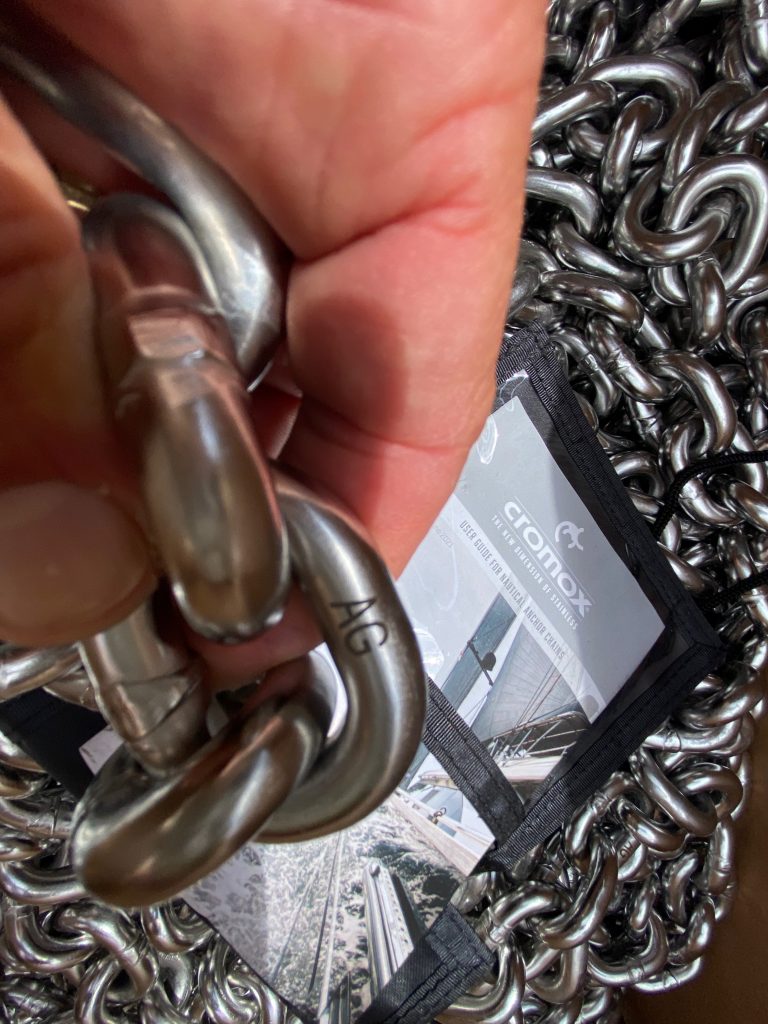
Accessories
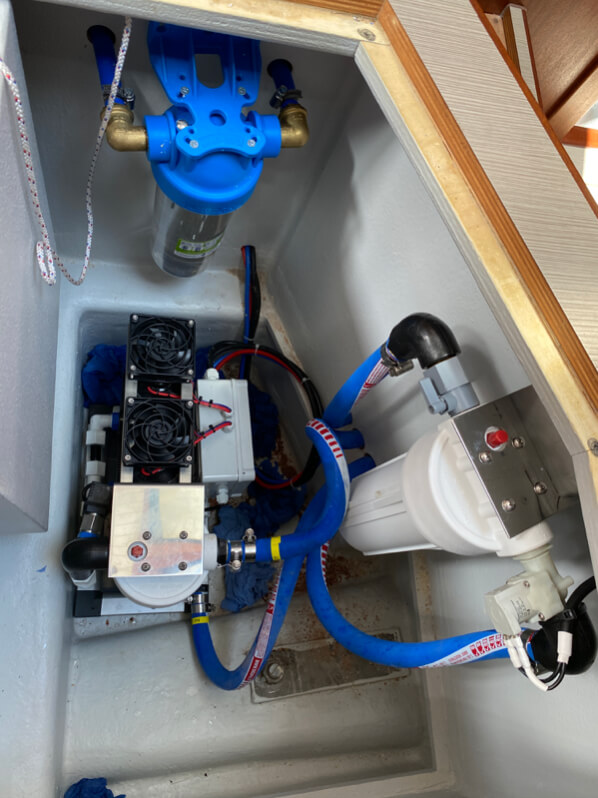
Watermaker: We have retrofitted a seawater desalination system since 2020 – the “Schenker Smart 60” model. It produces 60 liters of drinking water per hour and only draws 240 watts. This model also flushes automatically and can therefore stand for a few weeks without having to be shut down immediately. With the exception of the diesel, we are now really self-sufficient. In order not to spare the diesel, we have added two solar modules to the Bimini. We usually run the watermaker at noon on sunny days. The two water tanks are now ONLY filled by the watermaker, from where our (remineralized) drinking water is drawn. This has worked very well in the Mediterranean so far. The amount of plastic waste from the water bottles and the dragging was really on us. Especially on the Greek islands, where water is scarce in summer and not available in all ports, this is a real gain in freedom. The retrofitting, however, was quite a big act until all the hoses were pulled lengthways and across the ship….
Outboard engine: We decided for an electric outboard motor, the Torquedo 1003 Travel. It is very reliable, quiet and does not need gasoline. If you do not use it on top speed, it will last for 4 miles for a dinghy with 2-4 people in it. Sylvia and I only emptied the battery twice: once on a whole-day city tour through the canals of Copenhagen and another time in Lagos, Portugal, when we explored the rocky coast with four people in the dinghy. The display which shows the energy level is very reliable, which is why we always knew exactly, when to turn around. Once aboard, the motor can be charged in no time through the inverter.
However, more tha 4 knots speed is not possible, which is not enough to ‘glide’ over the waves. In the future, when we may have to cover longer ways against waves, wind and currents, we will probably need a bigger dinghy with a 9 PS motor. But – as long as we are able to sail around without gasoline in our storage lockers, we will continue using our trusty little e-motor.

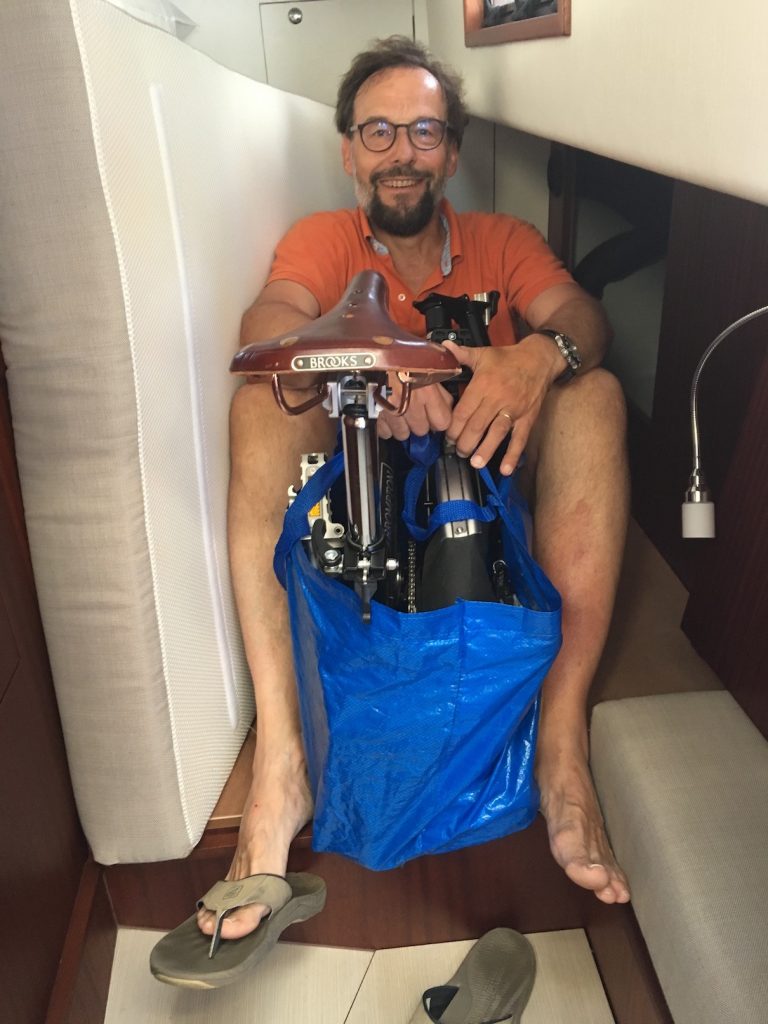
Folding bicycles: They vastly improved our transportation situation and our moving radius, once we were on land. We stored them behind the engine compartment. Two Brompton bicycles fit in there snugly, but it is a little hassle to get them out. This is why we only used them during longer stays or trips. However, we would not miss them for the world! They are amazing for sightseeing, smaller shopping trips and of course for the occasional sport session for the lazy sailor.
Vacuum cleaner: Why are we talking about such a minor detail? Because a ship attracts dirt like a magnet. It is unbelievable how much dirt can pile up in those hard to reach corners. The downside of a broom: as soon as one brings the just thoroughly filled dustpan up deck, half of it is blown over the ship. The answer is the very convenient hand held vacuum by Dyson. It is always easily accessible in a drawer by the stairs, so it is a matter of minutes to get it and clean the ship.
Electric water alarms: Again, very modern knick-knack. We have six little, battery operated water alarms positioned throughout the ship. Because we do not have a central bilge pump, where all water collects, but several, we get an early alarm whenever water is somewhere it is not supposed to be. One example: near Corse with high waves from behind, we heard the deafening alarm go off, since water had been getting in under the compartment we kept our bicycles. We quickly found the cause: when we lifted up the dinghy, it touched the cap of the safety swimming ladder. The waves pushed water through the pipe of the ladder, which was not watertight, due to a production error of the manufacturer. We spotted the evildoer quickly and were able to react immediately. Next year we will install two more alarms.
